I recently added a barely used C2300 into my system. My first McIntosh product. Sound is really great and solid, like you would expect. I really love having the remote control and I have just finished adapting my new SST-70 monoblock amps to utilize the 5vdc output control. Now the amps come on when I power up the Pre, very nice.
First up I replaced the stock tubes with 3 matched pairs of Genalex Gold Lion 12AX7's.
To replace the tubes you have to remove the top cover. McIntosh did a nice job on the component layout. The tubes and related caps/resistors/etc are mounted on a steel plate that is attached to chassis via rubber isolators. The top of the tubes are kind of wedged in place with a swing away top plate, also with rubber isolators.
I was a little disappointed to see that the input caps and coupling capacitors for both MM and MC operation along with the preamp stage are all $2 Wima caps.
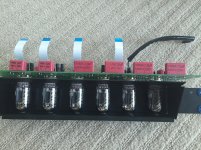
So next up is to replace the 3 pairs of input caps with Cardas Golden Ratio 0.1uF 600VDC caps all matched, the MC coupling caps with Mundorf Supreme Silver/Oil 1uF 690VAC caps matched, and the two pairs of coupling caps in the preamp stage with Mundorf Supreme Silver/Gold/Oil 0.22uF 690 VAC caps quad matched. Since I am using a MC cart I'm not changing the MM coupling caps. All caps are the same values as stock, FYI.
I'll report back if I can hear a difference, better or worse, by replacing $28 worth of stock caps with $460 caps.
I also used my Hagerman Frybaby2 to "burn in" the caps for a couple days.
I haven't found much available information on people modifying newer McIntosh products. So if anyone has any personal experience please share!
First up I replaced the stock tubes with 3 matched pairs of Genalex Gold Lion 12AX7's.
To replace the tubes you have to remove the top cover. McIntosh did a nice job on the component layout. The tubes and related caps/resistors/etc are mounted on a steel plate that is attached to chassis via rubber isolators. The top of the tubes are kind of wedged in place with a swing away top plate, also with rubber isolators.
I was a little disappointed to see that the input caps and coupling capacitors for both MM and MC operation along with the preamp stage are all $2 Wima caps.

So next up is to replace the 3 pairs of input caps with Cardas Golden Ratio 0.1uF 600VDC caps all matched, the MC coupling caps with Mundorf Supreme Silver/Oil 1uF 690VAC caps matched, and the two pairs of coupling caps in the preamp stage with Mundorf Supreme Silver/Gold/Oil 0.22uF 690 VAC caps quad matched. Since I am using a MC cart I'm not changing the MM coupling caps. All caps are the same values as stock, FYI.
I'll report back if I can hear a difference, better or worse, by replacing $28 worth of stock caps with $460 caps.
I also used my Hagerman Frybaby2 to "burn in" the caps for a couple days.
I haven't found much available information on people modifying newer McIntosh products. So if anyone has any personal experience please share!
Which are high-quality film caps made in large quantities for industrial use - and besides, that's about $1.70 more than what most people would have used to begin with.I was a little disappointed to see that the input caps and coupling capacitors for both MM and MC operation along with the preamp stage are all $2 Wima caps.
If you were an equipment designer and expected performance difference between said $2 WIMAs (with well-documented characteristics and from ISO certified production plants) and $$$ boutique audiophool parts (with generally far more nebulous specs, made in far smaller batches) would be pretty much exactly zilch, what would you use? Hint: Manufacturers generally don't feel like burning money.
If memory serves, PIO caps measure particularly bad (high DA). Might be exactly why people like 'em, actually!
690 VAC? Those suckers are huge - parasitics aplenty. That's something you could use in a speaker crossover (which is what they are usually sold for), a high-power tube amp or I don't know what. But hacking them into a poor little preamp, where they usually have to sustain pretty much 0 V, or 15-18 V max even during a fault condition... how's that even supposed to look? With some bad luck introducing some unwanted coupling could get the whole circuit oscillating (I've seen one mod hack job where oversized caps like that literally covered like half the circuit board in a power amp, with lead lengths to match, and for mysterious reasons it no longer worked properly...).
Which are high-quality film caps made in large quantities for industrial use - and besides, that's about $1.70 more than what most people would have used to begin with.
If you were an equipment designer and expected performance difference between said $2 WIMAs (with well-documented characteristics and from ISO certified production plants) and $$$ boutique audiophool parts (with generally far more nebulous specs, made in far smaller batches) would be pretty much exactly zilch, what would you use? Hint: Manufacturers generally don't feel like burning money.
If memory serves, PIO caps measure particularly bad (high DA). Might be exactly why people like 'em, actually!
690 VAC? Those suckers are huge - parasitics aplenty. That's something you could use in a speaker crossover (which is what they are usually sold for), a high-power tube amp or I don't know what. But hacking them into a poor little preamp, where they usually have to sustain pretty much 0 V, or 15-18 V max even during a fault condition... how's that even supposed to look? With some bad luck introducing some unwanted coupling could get the whole circuit oscillating (I've seen one mod hack job where oversized caps like that literally covered like half the circuit board in a power amp, with lead lengths to match, and for mysterious reasons it no longer worked properly...).
Thanks for taking the time to reply. Productive conversations are how we all learn.
I take from your reply that you don't have any person experience modifying McIntosh products, as I ended my first post? General comments are appreciated, if based on correct details.
The 1uF Wima coupling caps to be replaced are 630v rated, vs the 690v rating of the Mundorf. So McIntosh should have used these in their speakers instead of this Pre?
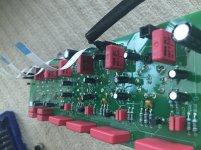
I'm not going to get graded on the results of my learning. Maybe loose some time and money if I don't like the results. Maybe in the process I learn what does what. A month from now I'll forget about the lost time and money.
Physically the replacement caps are either close to the same size or slightly larger. There is room on the boards to accommodate the extra size. I'm sure the term "hack" can apply to a lot of people. I have fixed some equipment for my HiFi friend that I would definitely call a hack job. I have all Hakko equipment, including their desoldering tool. If I don't like the results I can switch it back, like it never even happened, isn't that a commercial?
As far as the concept of boutique parts are concerned vs ISO certified parts, you must be dreaming if you think ISO certified actually means anything related to the actual design and performance of anything. This I do have personal experience with. ISO is mainly concerned with processes, record keeping and accountability/traceability. This might mean something if you were to compare against Chinese parts, but Cardas and Mundorf are not.
Of course every manufacturer builds each product with features and benefits to meet a price point. They also design around the other products in their line and their price points. Also under consideration is the time to the next update on the same product. How many ways can a preamp circuit be designed? And I agree, this Pre sounds great as it is, including the inexpensive caps. But what if, in an afternoon and $500 worth of parts, it sounds better?
No animals will be harmed in my cap replacement.
I'll report back with what I learn/hear!
I swapped out the caps yesterday morning, took me about 3 1/2" hours all in. Details, pics and review below, but to not have to read the whole post, all went well, sound is improved, no negatives!
This is a nice Pre, pretty cool design with the tubes showing in the glass top.
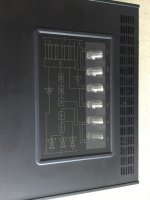
Isolation panel holding the tubes and circuit board. The 4 blue rings are the rubber grommets that isolate the panel, and the plate across the top of the tubes also have rubber O rings holding the top of each tube.
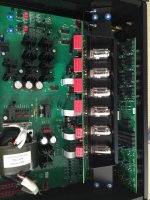
A week ago I connected all the caps up to my Frybaby2 and ran it for 48 hours to try and minimize break in time.
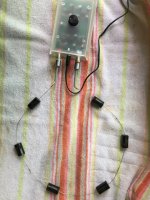
Here is the top view before its molested. I numbered each cap so I can put back in place if I don't like the results. You have to appreciate the clean look and neat organization.
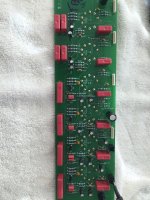
Like I mentioned in my previous post, I have Hakko tools including their desoldering station. Invaluable for this kind of work. I dabbed a little flux on each solder joint and then used the tool to suck out the solder. The flux really helps the tool suck all the solder. Here are pics of top and bottom after the removal. Looks like a new board and all the caps came out cleanly.
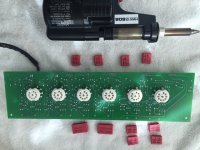
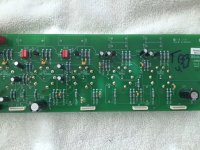
The new caps soldered in. I agree not as nice and neat, and the new caps take up more real estate. But I'll be listening to it not looking at the insides.
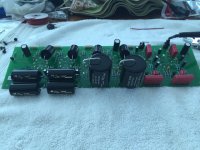
It did take a little planning on how to place the caps to miss everything. But as you can see, plenty of room. One cap looks like it's close to a heat sink, but it's the angle of the shot, over an inch and a half away.
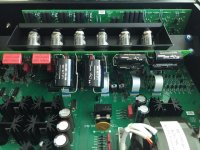
No startup issues at all, and I have about 10 hours of run time so far. I'm trying to keep an open mind and not rush to judge judgement as I know the caps will still take some time to fully form and sound their best.
But first impressions are all positive. The overall presentation is cleaner. Similar maybe to taking an overly obtrusive speaker grill off. I notice that especially on female vocals their voice is smoother, maybe less grainy. Small details like fingers on a guitar string and the decay of a piano key strike are more audible. But musical not clinical.
Anyway, I'm very pleased with the results so far. Well worth the time and investment. I've heard the Cardas caps can take 1000 hours to break in, so I'll report back in a couple months or so on how the experiment goes.
Sent from my iPad using Tapatalk
This is a nice Pre, pretty cool design with the tubes showing in the glass top.

Isolation panel holding the tubes and circuit board. The 4 blue rings are the rubber grommets that isolate the panel, and the plate across the top of the tubes also have rubber O rings holding the top of each tube.

A week ago I connected all the caps up to my Frybaby2 and ran it for 48 hours to try and minimize break in time.

Here is the top view before its molested. I numbered each cap so I can put back in place if I don't like the results. You have to appreciate the clean look and neat organization.

Like I mentioned in my previous post, I have Hakko tools including their desoldering station. Invaluable for this kind of work. I dabbed a little flux on each solder joint and then used the tool to suck out the solder. The flux really helps the tool suck all the solder. Here are pics of top and bottom after the removal. Looks like a new board and all the caps came out cleanly.


The new caps soldered in. I agree not as nice and neat, and the new caps take up more real estate. But I'll be listening to it not looking at the insides.

It did take a little planning on how to place the caps to miss everything. But as you can see, plenty of room. One cap looks like it's close to a heat sink, but it's the angle of the shot, over an inch and a half away.

No startup issues at all, and I have about 10 hours of run time so far. I'm trying to keep an open mind and not rush to judge judgement as I know the caps will still take some time to fully form and sound their best.
But first impressions are all positive. The overall presentation is cleaner. Similar maybe to taking an overly obtrusive speaker grill off. I notice that especially on female vocals their voice is smoother, maybe less grainy. Small details like fingers on a guitar string and the decay of a piano key strike are more audible. But musical not clinical.
Anyway, I'm very pleased with the results so far. Well worth the time and investment. I've heard the Cardas caps can take 1000 hours to break in, so I'll report back in a couple months or so on how the experiment goes.
Sent from my iPad using Tapatalk
Last edited:
Anyone making such a change can be sure they will hear an improvement. Even their wife in the kitchen will hear an improvement.Coasttocoast said:I'll report back if I can hear a difference, better or worse, by replacing $28 worth of stock caps with $460 caps.
ISO is mainly concerned with ensuring that you do what you said you would do, every time. Provided that what you said you would do is appropriate, this may be better than only sometimes doing what you said you would do.ISO is mainly concerned with processes, record keeping and accountability/traceability.
A coupling cap has a fairly simple job to do: pass low frequency AC (audio is quite low frequency), block DC, and not vibrate too much or couple too much to nearby circuitry. Almost any cap with the right value will work, provided it is not too large or badly made.
If you hear a difference after changing a coupling cap then probably either the original was faulty or it had the wrong value. One exception is the coupling cap which sets the LF rolloff - for this one the most likely reason for hearing a change is that the new one has a slightly different value to the old one. Another exception is if the new caps are so physically huge that they create lots of parasitic capacitance and so modify HF frequency response or cause instability.
If you hear a difference after changing a coupling cap then probably either the original was faulty or it had the wrong value. One exception is the coupling cap which sets the LF rolloff - for this one the most likely reason for hearing a change is that the new one has a slightly different value to the old one. Another exception is if the new caps are so physically huge that they create lots of parasitic capacitance and so modify HF frequency response or cause instability.
Interesting reply.
There are many capacitor comparisons/reviews by DIY hobbyists detailing benefits/differences/deficiencies of various capacitors used in varying equipment/positions in a circuit. And commercial equipment manufacturers like Cary that offer upgrade capacitor packages to their customers. I can't imagine that it all boils down to "slightly different value" to be able to appreciate a sonic improvement.
Conrad-Johnson's phono stage has three different price point pieces with the same/similar circuit with the differences in cost related to component choices. Capacitor choice is a significant one. Reviewers have detailed the sonic benefits as you move up the line. All attributed to "slightly different value"?
A quick google search of various phono stages shows commercial units with much larger value and physical size in use in the signal path, some performing coupling duties.
Art Audio, a well reviewed product at the time has a pair of 3.9 uF caps
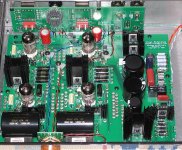
Balance Audio Technology has a "six pack" of 1uF coupling caps for each channel.
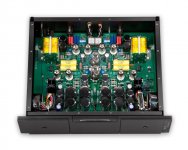
And Conrad-Johnson's TEA2 has a nice pair of physically large coupling caps per channel.
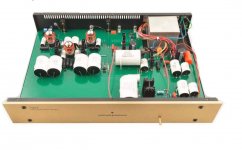
I have no personal experience with any of these products, but they were/are reviewed well by others.
So can you see my dilemma in trying to understand your comments in relation to my quick internet search to the contrary?
Sent from my iPad using Tapatalk
Reviewers look inside the box (although rarely understand what they see). Therefore anything which looks impressive is bound to make the unit 'sound better'. In a capitalist system the successful business is the one which sells the customer what he wants to buy; in some cases after having convinced him that he wants to buy what the business wants to sell. Eventually you can get a herd mentality, in which even those businesses which know that a particular 'upgrade' is a waste of money will still make it available to their customers because they have to be seen to be keeping up with fashion.Coasttocoast said:So can you see my dilemma in trying to understand your comments in relation to my quick internet search to the contrary?
Any sensible person would think that $400 of caps must sound better than $4 of caps. You need to be an engineer or scientist to know that this is not necessarily true, and may be false - in some cases perhaps the opposite of the truth.
People building precision electronics for medical, aerospace, military systems etc. do not use fancy expensive components - except where there is a good engineering reason to do so (which is very rare). Only in domestic audio does this happen routinely. Why is it that one of the least demanding applications of low frequency electronics seems to demand the 'best' component quality?
Reviewers look inside the box (although rarely understand what they see). Therefore anything which looks impressive is bound to make the unit 'sound better'. In a capitalist system the successful business is the one which sells the customer what he wants to buy; in some cases after having convinced him that he wants to buy what the business wants to sell. Eventually you can get a herd mentality, in which even those businesses which know that a particular 'upgrade' is a waste of money will still make it available to their customers because they have to be seen to be keeping up with fashion.
Any sensible person would think that $400 of caps must sound better than $4 of caps. You need to be an engineer or scientist to know that this is not necessarily true, and may be false - in some cases perhaps the opposite of the truth.
People building precision electronics for medical, aerospace, military systems etc. do not use fancy expensive components - except where there is a good engineering reason to do so (which is very rare). Only in domestic audio does this happen routinely. Why is it that one of the least demanding applications of low frequency electronics seems to demand the 'best' component quality?
So much misdirection and misinformation. If this thread wasn't started by me I would not reply. But since I did I feel responsible to provide balance to your comments.
Again, I have zero electronic education and am a very new novice to the whole of audio in general, that being said........
I posted pics of some preamplifier boards that used physically large caps and were successful commercial products that reviewed well to counter the posting that their use could/would actually be detrimental. Not to review the audio industry or reviewers in general. The product either works well or not. In a "capitalistic system" any manufacturer of any type of product will discontinue an item or go out of business if their product doesn't work or are inferior to their competition. Which, BTW, the caps as used in my system, perform positively.
I agree with the fact that higher cost does not always provide a better product.
I could write all day on how inaccurate your last paragraph is.
Music and hence audio, is art. It is well documented that science cannot measure/value everything that humans hear. So logic dictates that engineers cannot design audio gear solely by calculations. I agree they can get you maybe 90% there.
A more real world appreciable example of this is the high performance car industry. Engineers design the cars systems the best they can on paper and their so proud of their design. Then a driver take the car for a few laps around Nurburgring and send the engineers back to the drawing board. It just doesn't happen that engineering always get it right. Again, because everything cannot be measured and quantified on paper.
There are several of examples of "fancy expensive components" designed for aerospace, medical, telecommunications, etc. that the audio industry pics up for their use. The 6C33C tube designed for the Mig fighter jet, at a very high per unit cost, has quite a following in audio. The C3g tube was designed for telecommunications at a "cost no object" is used successfully in audio. While not an electronic product the Minus k isolation device built for medical equipment is almost a must have for the best of vinyl playback.
I would think that a true audiophile would be offended to think of his gear as "the least demanding" use of components.
Anyway....
If anyone has any experience with upgrading or modifying their McIntosh gear I would love to hear about it.
No need to spend a day on it; I would be happy to see the 5 minute version of your considered reply.Coasttocoast said:I could write all day on how inaccurate your last paragraph is.
Music is art, although firmly based on science. Audio is a mix of art and science, if by audio you mean making a sound which people find pleasant. Hi-fi (sound reproduction) is mostly science.Music and hence audio, is art.
Is that so? I thought the opposite is true. The human ear is very good at some things and extremely bad at others. The claim that science can't measure what we hear is usually made by people who don't like hi-fi but for some reason wish to pretend that they do.It is well documented that science cannot measure/value everything that humans hear.
These were designed to perform a very specific demanding task. In some cases they can work equally well for audio (perhaps unnecessarily so); in others they are merely expressions of 'fad engineering'.There are several of examples of "fancy expensive components" designed for aerospace, medical, telecommunications, etc. that the audio industry pics up for their use.
Probably, yes. An emotional response is not always a good guide to truth or falsity. Audio is low frequency, not too fussy about non-linear distortion, and fairly low power. Efficiency is usually a low priority. Video has much wider bandwidth. Radio requires much higher linearity, and sometimes much higher power. Instrumentation requires long-term stability. Medical/aerospace/military systems mean that someone dies if the circuit misbehaves. Audio is undemanding compared to these.I would think that a true audiophile would be offended to think of his gear as "the least demanding" use of components.
I realise this all this may be surprising to an audio electronics newbie, but facts are facts. Don't believe everything you read in audio magazines! In fact, the more you know the less you will believe them. Eventually you may, like me and many others on here, stop reading audio magazines altogether. There is far more wisdom on this forum than you will find in almost any magazine. About the only exception is the audio magazine written by people who are regular posters here - but it is quite unlike any other you may have seen.
If you go back to the beginning of McIntosh, or any other large audio company that's been around a while, they NEVER used anything "special" for passive parts, just good reliable proven parts. But yet they are some of the most sought after pieces worldwide, IF stock. The engineers used appropriate parts for the job at hand. The only hiccup thru out the years were the "bumblebee" capacitors but many companies had to deal those also. All of these "boutique" parts are all relatively new and some are not very reliable. Reliability HAS to be part of their overall goal.
Craig
Craig
Hi Coasttocoast,
You have inspired me to do the same to my C2300. Although I have been looking at the circuit and it looks like McIntosh put electrolytics inline on both the MC and Main inputs which baffles me. C33 and C34 both 1uf within the MC circuit and C49, C50, C51 and C52 again 1uf within the main circuit. I'm not an electrical engineer, but don't see why replacing those with some nice film capacitors would cause any issue. This change coupled with your changes would be substantial.
You have inspired me to do the same to my C2300. Although I have been looking at the circuit and it looks like McIntosh put electrolytics inline on both the MC and Main inputs which baffles me. C33 and C34 both 1uf within the MC circuit and C49, C50, C51 and C52 again 1uf within the main circuit. I'm not an electrical engineer, but don't see why replacing those with some nice film capacitors would cause any issue. This change coupled with your changes would be substantial.
If you want to do an actual test, changeover one channel and leave the other alone.
You won't be able to do blind comparison, but you will be able to hear before and after within seconds of each other.
I'm a member of the "one change at a time" club. Then you know exactly which things matter, and which don't.
I use piano source material for my audio tests. Piano is very hard to reproduce properly. I have a real piano for comparison, sitting between the speakers. Try some top octave solo material for a cheap HFIM distortion test.
Additionally, 95% of the men I know have blown their high frequency hearing out with motor vehicles, fireworks, weapons, or too much live performance. Ear damage doesn't cause pain. The army trained me to use earplugs at the firing range, and I still had up to 14 khz last time I was tested age 58. Which aptitude I am very greatful. The guys with the tin ears running the music performance at a group I volunteer with, I have no respect for. The head guy uses two hearing aids - but his opinion matters, not mine.
You won't be able to do blind comparison, but you will be able to hear before and after within seconds of each other.
I'm a member of the "one change at a time" club. Then you know exactly which things matter, and which don't.
I use piano source material for my audio tests. Piano is very hard to reproduce properly. I have a real piano for comparison, sitting between the speakers. Try some top octave solo material for a cheap HFIM distortion test.
Additionally, 95% of the men I know have blown their high frequency hearing out with motor vehicles, fireworks, weapons, or too much live performance. Ear damage doesn't cause pain. The army trained me to use earplugs at the firing range, and I still had up to 14 khz last time I was tested age 58. Which aptitude I am very greatful. The guys with the tin ears running the music performance at a group I volunteer with, I have no respect for. The head guy uses two hearing aids - but his opinion matters, not mine.
Last edited:
- Status
- This old topic is closed. If you want to reopen this topic, contact a moderator using the "Report Post" button.
- Home
- Source & Line
- Analog Line Level
- McIntosh C2300 modification